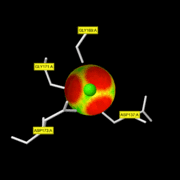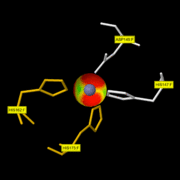Sandbox Reserved 1125
From Proteopedia
(Difference between revisions)
| Line 76: | Line 76: | ||
=== Synthetic inhibitors === | === Synthetic inhibitors === | ||
| + | |||
| + | Because endogenous TIMPs have a broad spectrum of action over MMPs, researches were conducted to produce engineered TIMPs and modify their affinity for MMPs. For instance, mutation of the Thr2 of TIMP-1 modify the specificity of this inhibitor as this residue interacts with the S1' pocket of the MMPs.<ref>PMID:20080133</ref> | ||
| + | |||
| + | Besides the modification of TIMPs, the research for MMPs inhibitors resulted in the discovering of molecules with the ability to interact with the catalytic domain of MMPs. The first developped synthetic inhibitors were molecules that mimic the natural substrates of MMPs combined with a zinc chelating groupement.<ref>PMID:19712708</ref> | ||
| + | Numerous range of compounds such as hydroxamate, thiol, pyrimidine and phosphorus based-molecules were developped. Those inhibitors inhibit the activity of MMPs by chelating the catalytic zinc like N-hydroxyurea for MMP-8. | ||
| + | |||
| + | Recently, new range of inhibitors which do not chelate the catalytic zinc were developped. Those compounds target the selectivity regions for substrates of the MMPs rather than binding to the catalytic zinc. For instance, they can interact with the S1' pocket and induce a conformational change like new inhibitors of MMP-8. | ||
| + | |||
| + | |||
Petites info Chrichri: | Petites info Chrichri: | ||
<font color='red'>MMP activity may subsequently be regulated by the action of inhibitors, notably the tissue inhibitors of MMPs (TIMPs) - TIMP-1, TIMP-2, TIMP-3 and TIMP-4 - and the serum panproteinase inhibitor α2 macroglobulin (Baker et al., 2002) The TIMPs are six-loop disulphide-bonded proteins forming two domains. They interact via their N-terminal three disulphide-bonded loops with the active site cleft of the catalytic domain, although significant interactions of the hemopexin-like domains of MMP-2 and MMP-9 with the C-terminal domains of TIMPs appear to have specific biological relevance. The other MMP domains have distinct functions, such as as exosites for substrate interactions, e.g. the hemopexin-like domains of MMP-1, MMP-8, MMP-13, MMP-14, MMP-16 and MMP-18 are essential for their ability to cleave fibrillar collagens and the fibronectin-like domains of MMP-2 and MMP-9 confer their binding to denatured collagen substrates. The hemopexin-like domain of MMP-14 can homodimerise in order to promote its clustering at the cell surface, a property that promotes its activity. The hemopexin-like domain confers the ability to interact with other extracellular matrix components and cell adhesion molecules and may be of significance in the determination of specific pericellular locations of individual MMPs. | <font color='red'>MMP activity may subsequently be regulated by the action of inhibitors, notably the tissue inhibitors of MMPs (TIMPs) - TIMP-1, TIMP-2, TIMP-3 and TIMP-4 - and the serum panproteinase inhibitor α2 macroglobulin (Baker et al., 2002) The TIMPs are six-loop disulphide-bonded proteins forming two domains. They interact via their N-terminal three disulphide-bonded loops with the active site cleft of the catalytic domain, although significant interactions of the hemopexin-like domains of MMP-2 and MMP-9 with the C-terminal domains of TIMPs appear to have specific biological relevance. The other MMP domains have distinct functions, such as as exosites for substrate interactions, e.g. the hemopexin-like domains of MMP-1, MMP-8, MMP-13, MMP-14, MMP-16 and MMP-18 are essential for their ability to cleave fibrillar collagens and the fibronectin-like domains of MMP-2 and MMP-9 confer their binding to denatured collagen substrates. The hemopexin-like domain of MMP-14 can homodimerise in order to promote its clustering at the cell surface, a property that promotes its activity. The hemopexin-like domain confers the ability to interact with other extracellular matrix components and cell adhesion molecules and may be of significance in the determination of specific pericellular locations of individual MMPs. | ||
Revision as of 13:33, 30 January 2016
Matrix metalloproteinase-8
MMP-8, also called, Neutrophil collagenase or Collagenase 2, is a zinc-dependent and calcium-dependent enzyme. It belongs to the Matrix metalloproteinase
(MMP) family which is involved in the breakdown of extracellular matrix in embryonic development, reproduction, and tissue remodeling, as well as in disease processes, such as arthritis and metastasis. The gene coding this family is localized on the chromosome 11 of Homo sapiens with 467 residues.[1]
| |||||||||||
References
- ↑ "MMP-8 matrix metallopeptidase 8 (neutrophil collagenase)"
- ↑ "Metalloendopeptidase activity"
- ↑ "Information on EC 3.4.24.34 - Neutrophil collagenase"
- ↑ Stams T, Spurlino JC, Smith DL, Wahl RC, Ho TF, Qoronfleh MW, Banks TM, Rubin B. Structure of human neutrophil collagenase reveals large S1' specificity pocket. Nat Struct Biol. 1994 Feb;1(2):119-23. PMID:7656015
- ↑ 5.0 5.1 Substrate specificity of MMPs
- ↑ Bode W, Reinemer P, Huber R, Kleine T, Schnierer S, Tschesche H. The X-ray crystal structure of the catalytic domain of human neutrophil collagenase inhibited by a substrate analogue reveals the essentials for catalysis and specificity. EMBO J. 1994 Mar 15;13(6):1263-9. PMID:8137810
- ↑ Bode W, Reinemer P, Huber R, Kleine T, Schnierer S, Tschesche H. The X-ray crystal structure of the catalytic domain of human neutrophil collagenase inhibited by a substrate analogue reveals the essentials for catalysis and specificity. EMBO J. 1994 Mar 15;13(6):1263-9. PMID:8137810
- ↑ Knauper V, Docherty AJ, Smith B, Tschesche H, Murphy G. Analysis of the contribution of the hinge region of human neutrophil collagenase (HNC, MMP-8) to stability and collagenolytic activity by alanine scanning mutagenesis. FEBS Lett. 1997 Mar 17;405(1):60-4. PMID:9094424
- ↑ Hirose T, Patterson C, Pourmotabbed T, Mainardi CL, Hasty KA. Structure-function relationship of human neutrophil collagenase: identification of regions responsible for substrate specificity and general proteinase activity. Proc Natl Acad Sci U S A. 1993 Apr 1;90(7):2569-73. PMID:8464863
- ↑ Van Wart HE, Birkedal-Hansen H. The cysteine switch: a principle of regulation of metalloproteinase activity with potential applicability to the entire matrix metalloproteinase gene family. Proc Natl Acad Sci U S A. 1990 Jul;87(14):5578-82. PMID:2164689
- ↑ Chung L, Dinakarpandian D, Yoshida N, Lauer-Fields JL, Fields GB, Visse R, Nagase H. Collagenase unwinds triple-helical collagen prior to peptide bond hydrolysis. EMBO J. 2004 Aug 4;23(15):3020-30. Epub 2004 Jul 15. PMID:15257288 doi:http://dx.doi.org/10.1038/sj.emboj.7600318
- ↑ Piccard H, Van den Steen PE, Opdenakker G. Hemopexin domains as multifunctional liganding modules in matrix metalloproteinases and other proteins. J Leukoc Biol. 2007 Apr;81(4):870-92. Epub 2006 Dec 21. PMID:17185359 doi:http://dx.doi.org/10.1189/jlb.1006629
- ↑ Visse R, Nagase H. Matrix metalloproteinases and tissue inhibitors of metalloproteinases: structure, function, and biochemistry. Circ Res. 2003 May 2;92(8):827-39. PMID:12730128 doi:http://dx.doi.org/10.1161/01.RES.0000070112.80711.3D
- ↑ Knauper V, Docherty AJ, Smith B, Tschesche H, Murphy G. Analysis of the contribution of the hinge region of human neutrophil collagenase (HNC, MMP-8) to stability and collagenolytic activity by alanine scanning mutagenesis. FEBS Lett. 1997 Mar 17;405(1):60-4. PMID:9094424
- ↑ "Neutrophil collagenase"
- ↑ Visse R, Nagase H. Matrix metalloproteinases and tissue inhibitors of metalloproteinases: structure, function, and biochemistry. Circ Res. 2003 May 2;92(8):827-39. PMID:12730128 doi:http://dx.doi.org/10.1161/01.RES.0000070112.80711.3D
- ↑ Nagase H, Visse R, Murphy G. Structure and function of matrix metalloproteinases and TIMPs. Cardiovasc Res. 2006 Feb 15;69(3):562-73. Epub 2006 Jan 5. PMID:16405877 doi:http://dx.doi.org/10.1016/j.cardiores.2005.12.002
- ↑ "Metalloprotease-inhibitor Complex"
- ↑ Brew K, Nagase H. The tissue inhibitors of metalloproteinases (TIMPs): an ancient family with structural and functional diversity. Biochim Biophys Acta. 2010 Jan;1803(1):55-71. doi: 10.1016/j.bbamcr.2010.01.003. , Epub 2010 Jan 15. PMID:20080133 doi:http://dx.doi.org/10.1016/j.bbamcr.2010.01.003
- ↑ Jacobsen JA, Major Jourden JL, Miller MT, Cohen SM. To bind zinc or not to bind zinc: an examination of innovative approaches to improved metalloproteinase inhibition. Biochim Biophys Acta. 2010 Jan;1803(1):72-94. doi: 10.1016/j.bbamcr.2009.08.006. , Epub 2009 Aug 25. PMID:19712708 doi:http://dx.doi.org/10.1016/j.bbamcr.2009.08.006
- ↑ Baker AH, Edwards DR, Murphy G. Metalloproteinase inhibitors: biological actions and therapeutic opportunities. J Cell Sci. 2002 Oct 1;115(Pt 19):3719-27. PMID:12235282
- ↑ "Extra Binding Region Induced by Non-Zinc Chelating Inhibitors into the S1′ Subsite of Matrix Metalloproteinase 8"
- ↑ Savill NJ, Weller R, Sherratt JA. Mathematical modelling of nitric oxide regulation of rete peg formation in psoriasis. J Theor Biol. 2002 Jan 7;214(1):1-16. PMID:11786028 doi:http://dx.doi.org/10.1006/jtbi.2001.2400
- ↑ Liu KZ, Hynes A, Man A, Alsagheer A, Singer DL, Scott DA. Increased local matrix metalloproteinase-8 expression in the periodontal connective tissues of smokers with periodontal disease. Biochim Biophys Acta. 2006 Aug;1762(8):775-80. Epub 2006 Jul 22. PMID:16928431 doi:http://dx.doi.org/10.1016/j.bbadis.2006.05.014
- ↑ Balbin M, Fueyo A, Knauper V, Pendas AM, Lopez JM, Jimenez MG, Murphy G, Lopez-Otin C. Collagenase 2 (MMP-8) expression in murine tissue-remodeling processes. Analysis of its potential role in postpartum involution of the uterus. J Biol Chem. 1998 Sep 11;273(37):23959-68. PMID:9727011
- ↑ Brand KH, Ahout IM, de Groot R, Warris A, Ferwerda G, Hermans PW. Use of MMP-8 and MMP-9 to assess disease severity in children with viral lower respiratory tract infections. J Med Virol. 2012 Sep;84(9):1471-80. doi: 10.1002/jmv.23301. PMID:22825827 doi:http://dx.doi.org/10.1002/jmv.23301
- ↑ Gao M, Nguyen TT, Suckow MA, Wolter WR, Gooyit M, Mobashery S, Chang M. Acceleration of diabetic wound healing using a novel protease-anti-protease combination therapy. Proc Natl Acad Sci U S A. 2015 Dec 8;112(49):15226-31. doi:, 10.1073/pnas.1517847112. Epub 2015 Nov 23. PMID:26598687 doi:http://dx.doi.org/10.1073/pnas.1517847112
RESSOURCE : Image:2oy4 mm1.pdb ( la structure du monomère )


